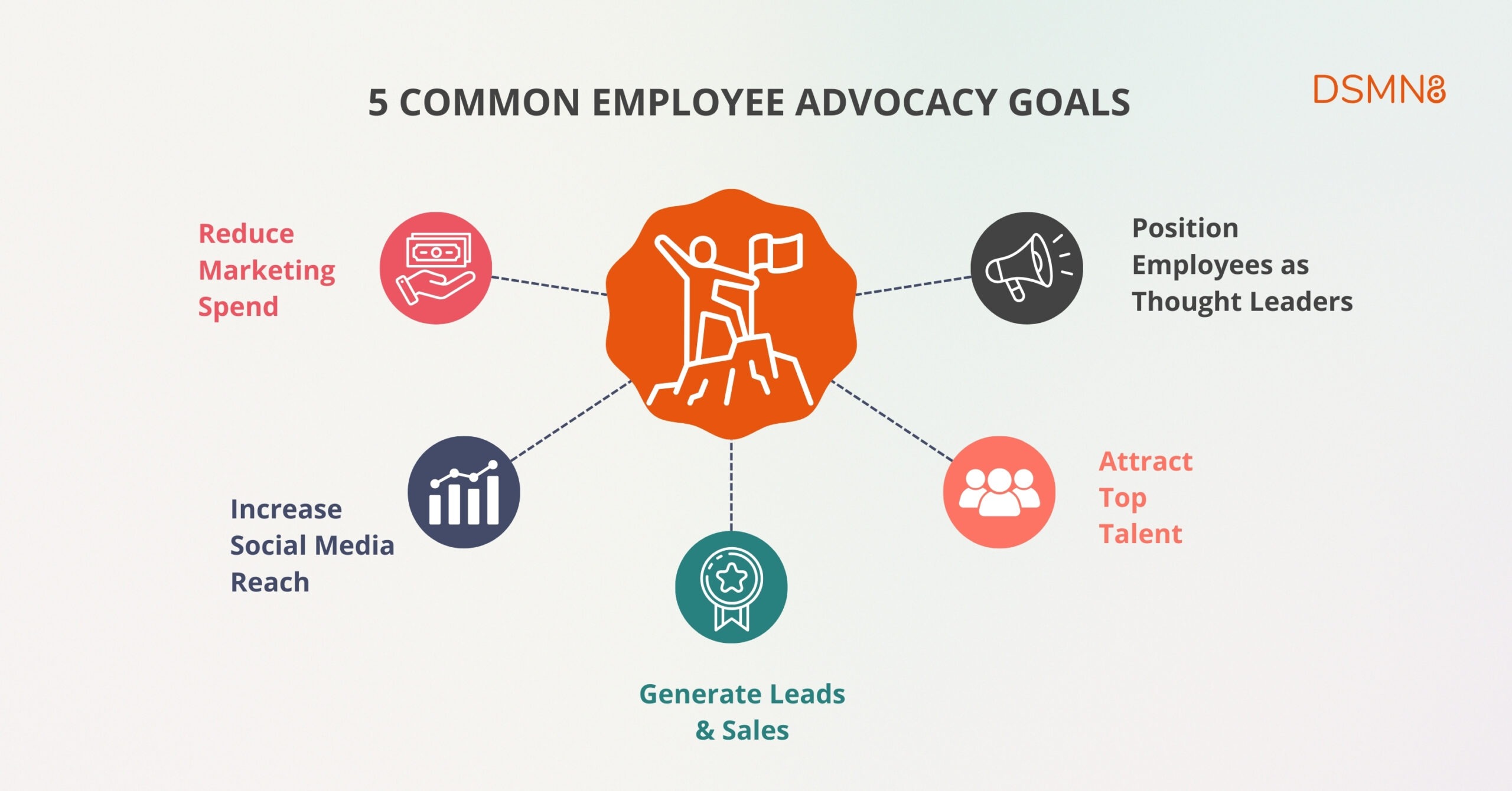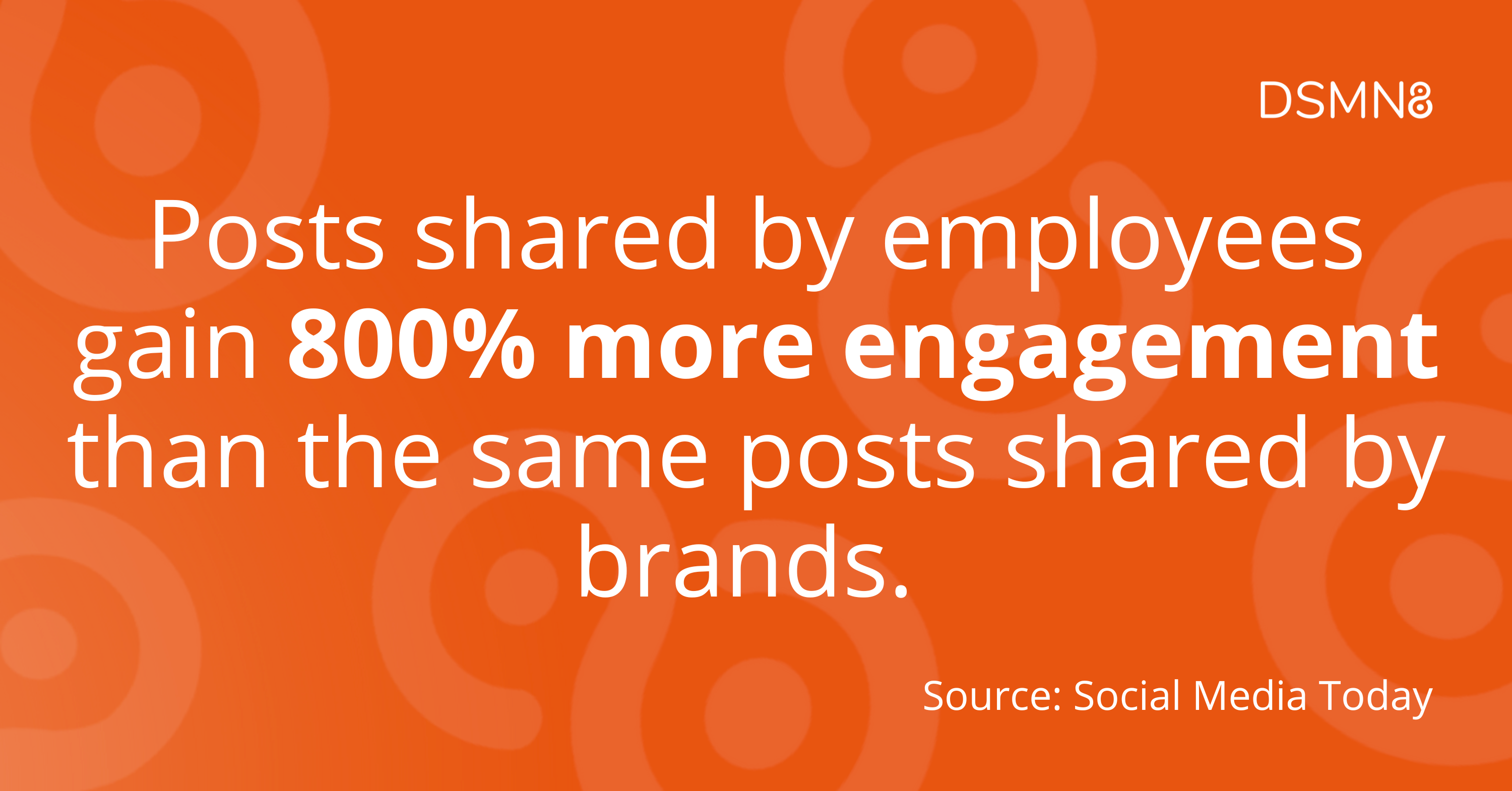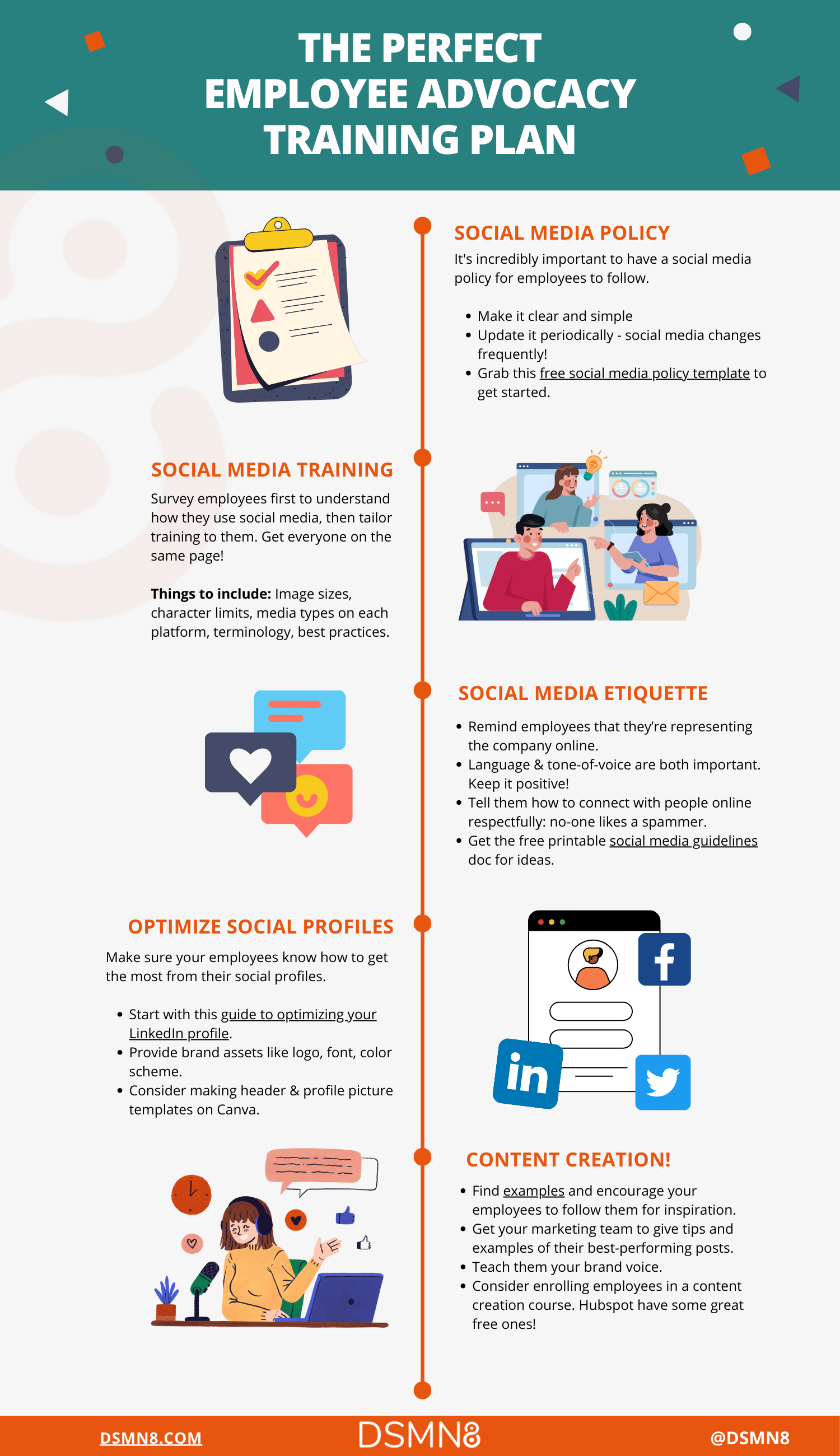
Last Updated: 14th January 2025
When starting an employee advocacy program, one of the most important parts to get right is the training. Providing your team with the tools they need for success is crucial for getting them on board, and increasing employee engagement.
Most employee advocacy programs see a return on investment in the first month, and we’ve found that implementing a social media training plan is the best way to ensure success.
In this post, you’ll find our top tips on how to create the perfect employee advocacy training plan. Drawing from our experience supporting hundreds of programs, we’re here to get your team active and effective on social 🙌
You’ll learn everything from why employees need social media training to what you should include in your social media policy and guidelines.
Why Employees Need Social Media Training
Whether your employees are digital natives or not, you’ll need to give them some social media training. Even if they already use LinkedIn on a daily basis, creating a training plan is important for ensuring everyone is on the same page.
This is why:
- You need to get employees up-to-speed on how to use the social media platforms you’d like them to share on, and the terminology. There’s no point telling employees to use a branded hashtag if they don’t know what a hashtag is.
- There’s a difference between personal and professional social media use, so you must ensure everyone knows what’s okay and what isn’t.
- Social media etiquette is important. No one likes a spammer! 😳
If your organization is in a regulated industry, social media training becomes even more critical.
Your employees must know the applicable laws to follow, such as marketing/advertising regulated products. You don’t want a legal headache later!

Tell Employees Why They Should Get Involved
Don’t tell employees to post on social media without explaining why.
Make it exciting! Talk about the opportunity employee advocacy presents for both your company and its employees.
Explain that employee advocacy helps with marketing, social selling, and employer branding.
Think about all of the incredible content your marketing team spends hours creating. They want it to be seen!
But don’t make it all about how their social media activity benefits your organization.
Let employees know how advocacy benefits them, e.g., career opportunities it can bring and, depending on their role, how it can make their jobs easier 👏

1. Set Your Goals
The first step is to set goals for your employee advocacy program.
The best way to establish goals is by looking at the your company’s values and objectives, then aligning your employees advocacy program with them.
For example, your program goals could be:
-
Reach and engage with your target audience on social media to build brand awareness and trust.
-
Showcase your company culture on social to attract top talent in your recruiting campaigns.
-
Generate more high-quality leads for your sales team.
Most importantly, tell your employees what the goals and KPI’s are.
They need to understand what the point of the program is or they’re unlikely to feel motivated to join.
2. Brand Vision & Values
Think about your brand vision and values – how can your employees help showcase that on social media?
Is your company culture big on sustainability? Encourage employees to post about their volunteering on LinkedIn! 🌱
Does your company culture prioritize empowering women in the workplace? Encourage your female leaders to share their insights and talk about their career journey to inspire other women in your sector.
Ensure that your entire team understands what your company values are, and give them ideas for demonstrating this on social.
It’ll help attract the talent you’re looking for: the people your team would love to have as colleagues.

3. Give Them The Statistics
Sharing the stats is a great way to get employees excited about advocacy and help them understand how it makes their jobs easier.
Here are some of our favorite employee advocacy statistics:
- Posts shared by employees have 800% more engagement than the same posts shared by official brand accounts. [Social Media Today]
- 76% of individuals surveyed say that they’re more likely to trust content from individuals over content from brands. [AdWeek]
- There’s a 700% greater conversion frequency when leads come from employees on social media. [Marketing Advisory Network]
- 75% of B2B buyers use social media to support purchase decisions. [LinkedIn]
4. Emphasize What's In It For Them
Don’t forget to let employees know what’s in it for them.
Explain that you’re moving away from a ‘no social media at work’ mindset to a policy that encourages employees to build their own personal brand.
Fun Fact: 86% of employees in an advocacy program said their engagement on social media had a positive impact on their career, according to Hinge Research.
Most importantly, make it clear you’re not forcing them to post on social media.
The last thing employees want is to feel like a free marketing channel!
Check out our guide to the benefits of employee advocacy for employees for more on how building a professional personal brand supports their careers.
How to Approach Employee Advocacy Training
We’ve covered the why, so let’s get on to the how.
Creating the perfect employee advocacy training plan will be different for every company, but following these steps will get you on the right track.
Do This First
Find out how your employees use social media before conducting or even planning any workplace social media training.
Do they use it for personal reasons, like keeping in touch with family, or do they post thought leadership content on LinkedIn for career development?
Depending on your survey results, you may need to offer different training for different groups of people based on their social media experience. While social media has become a big part of modern life, it’s important to remember that not everyone uses it!
On the other hand, your team might already use LinkedIn every day. In this case, your training should be a bit more in-depth than a ‘social media 101’.
Asking employees directly by sending out a simple survey allows you to evaluate their training needs accurately and avoid making assumptions.
Training Methods To Consider
Flexible training is the best approach, especially with remote/hybrid workers.
Host a Webinar. The great thing about webinars is that you can record them for anyone who missed them and show them to future new starters. Work smarter, not harder! 😉
Would an in-person workshop be better for your company? If you’re a smaller team, this hands-on approach could work really well. Have employees experiment with the platform, create some content, and get feedback from your social media experts! For large enterprises, build a training slide deck and deliver it through an online workshop or multiple sessions with smaller groups.
Train up some brand ambassadors, so they can train other employees. Appoint employee advocacy champions! 💪
Think about enrolling your employees in an online course. Hubspot offers some excellent free social media and content creation courses. A great place to start is getting your team to take our free Employee Advocacy Certification course.
Create documents as part of your employee advocacy training plan. Your colleagues can refer to them when needed. For example, your brand guidelines, tips for creating LinkedIn posts, hashtags to use on social, and social media banners to use on their profiles.
If you use an employee advocacy platform, do they offer training? (We do! More on that later…)
Don't Wait!
Don’t wait too long after launching an advocacy program before giving your staff some training.
Employees might sign up, then get confused and give up 🤦♀️
The first few months of an employee advocacy program are essential for driving and maintaining interest in the initiative. Read our guide on what to do during the first 60 days to set up for success.
What to Include in Your Training Plan

💡 Grab the Employee Advocacy Training Plan Checklist PDF for later.
First, make sure your IT department allows employees to access social media at work. There’s no use asking your people to get social if social media networks are blocked 🫢
Update your social media policy and have it ready to share with current employees and new starters.
1. Social Media Training
This part is super important: social media training.
Start with the basics. Which platforms you’d like employees to post on, and how do they work?
Teach them about social media image sizes, character limits, and types of media to share on each platform.
Try creating a checklist of social media terminology to help your less social-media-savvy employees! Hashtags, stories, lives, shares, likes, connections… it can all be confusing for a beginner.
2. Social Media Etiquette
When talking about professional social media behavior, cover things like:
- Language and tone-of-voice. Keep it positive!
- How to reach out and connect with people on LinkedIn.
- Controversial opinions. Make it clear that you’re not attempting to stifle free speech, but that employees should remember that they are representing the company. Don’t say anything online that you wouldn’t want your boss to hear!
Consider putting together an FAQ document, so your employees know how to answer questions and where to direct other queries they may receive.
3. Optimizing Social Profiles
After they’ve got to grips with professional social media use, terminology and etiquette, employees need to optimize their social profiles.
Give them guidance on how to make their profiles public, and provide branding assets.
Using your color scheme, logo and font is a great way to make employee profiles consistent. Consider making profile picture and header templates on Canva for your team to use.
Check out our post on how to optimize your LinkedIn profile for a detailed guide on getting started. Be sure to download our LinkedIn profile checklist to give your employees.
Making this process quick and easy is key. You don’t want your team agonizing over whether their profile is perfect before they even start sharing content.
4. Content Creation
Now, your team knows why they should be active on social media and how to use it. Their profiles are optimized and ready to go.
It’s time for the fun part: content creation!
Now, some of your employees might already be great at this. You’ve probably got some secret writers on your team 💻
Writing and creating content might not come naturally to others, so it’s a good idea to give everyone a few pointers.
The best way to do this is by using examples. Read our post featuring eight brands smashing it on social media for some inspiration. Find your own examples, too – extra points if they’re in your industry. Encourage your colleagues to follow them on LinkedIn for ideas.
Get your marketing team to give tips on things like brand voice and provide some of their best-performing social posts for inspiration. They’re the experts!
5. Your Employee Advocacy Platform
If you’re using an employee advocacy platform, it’s imperative that employees know how to get the most from it.
Your employee advocacy solution is likely to provide this training themselves: we do here at DSMN8.
We love our platform and want everyone to know how to use it for the best results! 🙌
How To Create a Social Media Policy
OK, so you know that a social media policy is important.
But what should it include?
Here’s the key: make it simple 💡
There’s simply no need for a 45-page document detailing every single scenario an employee could face on social media. That would be more likely to deter employees from sharing content than encourage it!
Use our customizable social media policy template to get started.
Make sure to update your social media policy periodically, preferably every year. Social media evolves very rapidly, and you’ve gotta stay with the times.
Do you want employees to post TikTok videos or stick to LinkedIn? Let them know!
Get Leadership Involved
One of the fundamentals for ensuring success from the outset is to get senior leadership involved.
If employee advocacy is backed by C-Suite executives, the rest of your company is likely to follow suit.
These executives are also more likely to have a larger social media following than any other employee and may already share thought leadership content.
Plus, they know your company inside out! They know your business goals and values and why visibility is important.
So, one of your priorities should be encouraging your senior leadership team to set an example for the rest of the company.
Spread the Word With Internal Comms
Whether you have an internal comms app, an intranet, or simply communicate by email… you’ll need to tell everyone about your new employee advocacy program!
If you decide to onboard a small team initially as a pilot program, keep a close eye on the results. Then, once you decide to onboard the wider team, you can really emphasize how well employee advocacy works… and have the numbers to prove it. We’ve found that this is a particularly effective method for encouraging user adoption.
Not sure which numbers to track? Read our guide on employee advocacy metrics.
Don’t let employee advocacy go stale 😫
Make social media part of your company culture. Share behind-the-scenes content, encourage new recruits to get involved, and provide regular social media post inspiration.
A great way to maintain interest in your advocacy program is by celebrating successes and recognizing employees for their social media efforts. Keep it fun, and use the power of FOMO (fear of missing out) to get more people involved.
Using internal comms to keep everyone up-to-date is key: if your company has recently won an award or introduced a new sustainability project, make everyone aware. This gives your employees ideas for their content.
DSMN8’s Expert Customer Success Team
Whether you’re brand new to employee advocacy or switching from another platform, DSMN8 has got your back 🤝
Our customer success team takes you through the entire process, from setting up your advocacy platform to training employees and executive leaders on how to use it.
We have the experience and the resources to support your advocacy program and tailor training to your company’s needs.
- Want to train several admins, who will then train your employees? Great.
- Want to onboard a small team, then later introduce it to the wider company? No problem.
- Want us to train your entire company? We can do it!
Your customer success manager is happy to host training webinars with your employees. They’ll provide video tutorials and a bunch of resources to support you 👏
Our experts have a huge knowledge base and are ready to support community-led growth through the voices of your employees.
Get Certified in Employee Advocacy
Want to become the employee advocacy expert at your organization?
Register for free access to our course, the Employee Advocacy Certification.
The course features 12 modules of on-demand video training provided by DSMN8 CEO and employee advocacy practitioner Bradley Keenan.
Become certified in employee advocacy today!
Ready to build a thriving community of employee advocates?
Book a demo of DSMN8, the #1 employee advocacy platform as rated by G2 users.
More Resources to Support Employee Advocacy Training:
Emily Neal
SEO and Content Specialist at DSMN8. Emily has 10 years experience blogging, and is a pro at Pinterest Marketing, reaching 1 million monthly views. She’s all about empowering employees to grow their personal brands and become influencers.



